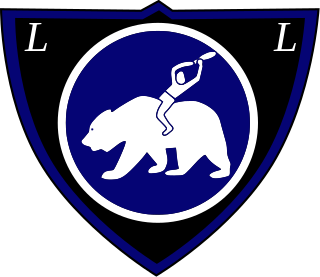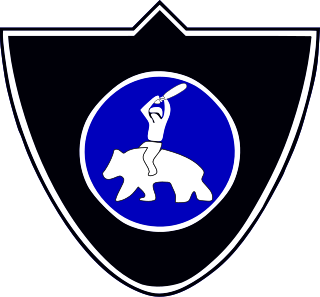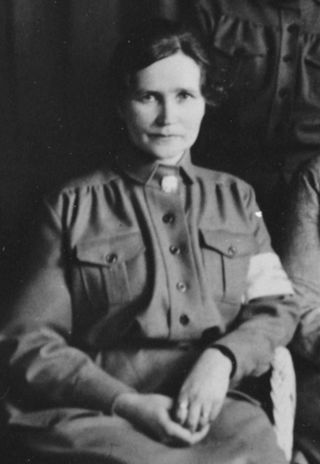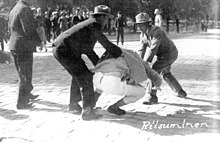
The Centre Party, officially the Centre Party of Finland, is an agrarian political party in Finland.

The Lapua Movement was a radical Finnish nationalist, fascist, pro-German and anti-communist political movement founded in and named after the town of Lapua. Led by Vihtori Kosola, it turned towards far-right politics after its founding and was banned after a failed coup d'etat attempt in 1932. The movement's anti-communist activities continued in the parliamentarian Patriotic People's Movement.

Patriotic People's Movement was a Finnish nationalist and anti-communist political party. IKL was the successor of the previously banned Lapua Movement. It existed from 1932 to 1944 and had an ideology similar to its predecessor, except that IKL participated in elections with limited success.

The Mäntsälä rebellion was a failed coup attempt by the Lapua Movement to overthrow the Finnish government.

Lapua is a town and municipality of Finland.

Iisakki Vihtori Kosola was the leader of the Finnish right-wing radical Lapua Movement.

Madame Minna Craucher was the false name of Maria Vilhelmiina Lindell, a Finnish socialite and spy. Her home was a noted salon for various writers and artists. She also did espionage, originally for the Cheka, the Soviet secret police, and was arrested three times for fraud. She also had connections to the right-wing Lapua Movement. She became the subject of several books and stories. In 1932 she was murdered with a shot to the head.
Left Group of Finnish Workers was a socialist political party in Finland. The party was active in the late 1920s and early 1930s. The group was founded by activists who had previously cooperated with the Communist Party of Finland (SKP). Niilo Wälläri, Eino Pekkala, Erkki Härmä and Kusti Kulo were some of the well-known leaders of the group. The group had supporters mainly in the southern industrial cities of Finland.
Radical People's Party was a Finnish radical populist socialist political party led by Ernesti Hentunen. The party was active in the 1940s and 1950s. The Radicals participated three times in the parliamentary elections and once in the municipal elections. They were left without MPs, but Hentunen served in the Helsinki City Council in 1948–1950. The party paper was Totuuden Torvi.

Hilja Elisabet Riipinen was a Finnish politician involved with the nationalist and anti-communist Lapua Movement and Patriotic People's Movement (IKL). She was a member of parliament between 1930 and 1939, first elected from the electoral list of the National Coalition Party, but she defected to the Patriotic People's Movement after it was formed as a political party in 1933.

The Night Frost Crisis or the Night Frost was a political crisis that occurred in Soviet–Finnish relations in the autumn of 1958. It arose from Soviet dissatisfaction with Finnish domestic policy and in particular with the composition of the third government to be formed under Prime Minister Karl-August Fagerholm. As a result of the crisis, the Soviet Union withdrew its ambassador from Helsinki and put pressure on the Finnish government to resign. The crisis was given its name by Nikita Khrushchev, who declared that relations between the countries had become subject to a "night frost".

Eino Oskari Pekkala was a Finnish lawyer and politician. He was a member of the Parliament of Finland, representing the Socialist Electoral Organisation of Workers and Smallholders 1927–1930 and the Finnish People's Democratic League 1945–1948. In the 1920−1930s, Pekkala was twice in prison for his political activities, and he was even kidnapped by the fascist Lapua Movement in 1930. As the political situation in Finland changed after the World War II, Pekkala was the Minister of Education 1945–1946, and the Minister of Justice 1946–1948.

Onni Happonen was a Finnish politician representing the Social Democratic Party of Finland. He was kidnapped and murdered by the fascist Lapua Movement.

In Finland, the far right was strongest in 1920–1940 when the Academic Karelia Society, Lapua Movement, Patriotic People's Movement (IKL) and Export Peace operated in the country and had hundreds of thousands of members. In addition to these dominant far-right and fascist organizations, smaller Nazi parties operated as well.

The Peasant March was a demonstration in Helsinki on 7 July 1930 by the far-right Lapua movement, attended by more than 12,000 supporters from all over the country. It was the most significant show of strength in the short history of the Lapua movement, aimed primarily at the Communists, but it was also intended to put pressure on the Finnish government. President Lauri Relander, Prime Minister Pehr Evind Svinhufvud, among others, were invited guests at the main event held at the Senate Square. In addition present were right-wing MPs, the country's military leadership, and General Mannerheim, commander-in-chief of the Civil War White Army. The peasant march was intentionally reminiscent of the White Victory Parade of 16 May 1918, and also followed its route.

Arvi Kalsta was a Finnish Jaeger captain, the founder of the Nazi Finnish People's Organisation and a businessman. In the 1930s, the Finnish Nazis who belonged to his supporters were called Kalstaites.

Martti Aleksander Pihkala was a National Coalition Party MP who became known as a Jäger activist, Ostrobothnia White Guard founder, in the 1920s and 1930s, leader of the strikebreaking organisation Export Peace, also known as "Pihkala's Guard" and an influencer of the Lapua movement and the Patriotic People's Movement.
Niilo Vilho Rauvala was a Finnish engineer and the chairman of the far-right Lalli Alliance of Finland and the Nazi Party of Finnish Labor in the 1930s and 1940s.
The Lalli Alliance of Finland was a Finnish far-right organization founded in 1929. The main themes of the Lalli Alliance were Finnish language nationalism and opposition to communism, parliamentarism and democracy. The aim of the organization was a coup and the appointment of a dictator to lead Finland. The most significant achievement of the organization is considered to be that the Lalli Alliance has been considered to have acted as a precursor to the Lapua movement.
Front Soldier League was a Finnish civil war White Guard veteran organization between the years 1929 and 1944, which also had extreme right-wing political objectives. In the early 1930s, it had close links with the Lapua movement, in which the leaders of the League played an important role. The Front Soldier League was abolished in 1944 on the basis of the Moscow peace treaty, which forbade fascist organizations. It had a sister organization for women, the Front Soldier Women's League, which was also disbanded.














